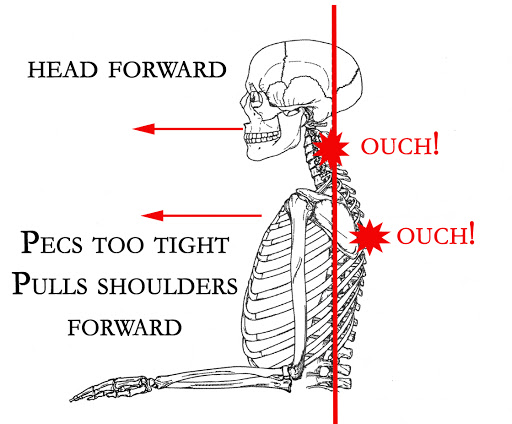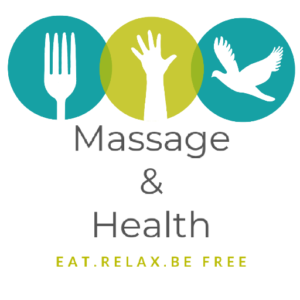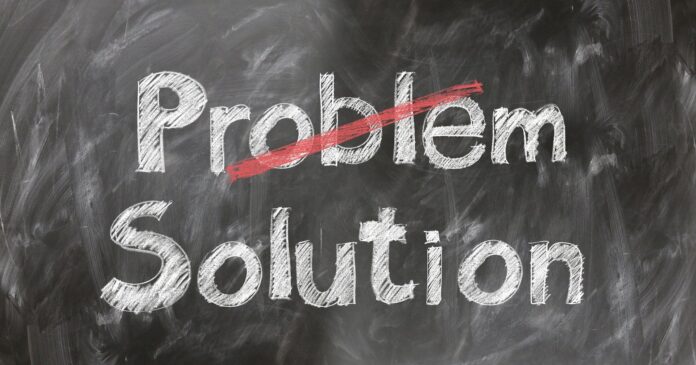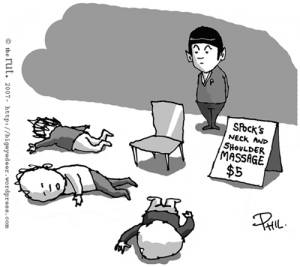- NECK PAIN
- LOW BACK PAIN
- ACHING BETWEEN THE SHOULDER BLADES
- HEADACHES
- PLANTAR FASCIITIS
- HAND/ARTHRITIS
- CARPAL TUNNEL SYMPTOMS
- FIBROMYALGIA
- TMJ
- DIGESTIVE ISSUES/SCIATICA
 Sitting at a desktop computer.
Sitting at a desktop computer.The keyboard and mouse should be as level as possible to the height of your elbows. The chair height needs to be adjusted high enough to allow the shoulders to hang naturally and relaxed letting the elbow bend comfortably to type and operate the mouse. This means your desk will be a little higher than your belly button! Like that’s ever happened. This avoids raising and “holding” your shoulder up, in which we have no idea we do. The monitor should be eye level. Looking down makes us lean forward, tensing the back of the neck to hold up the head . Looking up tenses the front of the neck and can possibly pinch the sweet little vertebrae. Unfortunately the desk manufacturer doesn’t know the chair manufacturer and nobody knows who made the mouse, my point being most of these things don’t work together. You may have to remove the arm rests from your chair which are probably not in the right position for you in the first place. We are all going to eventually look like Larry King, I swear his ears are going to permanently attach to his shoulders someday. “Love you Larry.” Elevate your monitor using something thick and sturdy enough to not shift. I use the extra phone books I seem to get every year. If you are writing and typing work more on looking down with your eyes instead of wrenching your neck forward. This helps to exercise the eye muscles and helps with strain.
Again, find a position that relaxes your shoulders and arms, adjust the screen and look with your eyes not your neck. One more reason I am opposed to the “glossy” screens that creates nothing but glare and poor adjustments, constantly looking for the best spot with the least view of the crap behind me. Although, in some sort of James Bond way I guess that could be cool. Headaches be gone.
We all know the downfall to repetitive movements. Unless you’ve been diagnosed from a physician with carpal tunnel syndrome you may be experiencing pain associated with Thoracic Outlet Syndrome. According to Wikipedia the two main causes are those in motor vehicle accidents, computer users or those who sit in “non-ergonomic postures for extended periods of time.” Mainly affected are the scalenes, those wonderful muscles at each side of our neck that pop out when we make the lizard face. The help stabilize the head when too far forward. Tightening of these muscles compresses the nerves and blood vessels going to the arm. Pain usually starts with tingling fingers, aching wrists moving up the arm.
One solution idea:
Stretch the scalenes. Slow neck rolls do wonders.
Massage the wrists, top and bottom using small circular motions. No oil is needed. This is a “needing” action not a gliding action. Compress with the thumbs. Open and close the hands very slowly. Joints require fluid to move smoothly and freely. Moving a joint too fast and repetitively can “dry up” this fluid. Moving slowly encourages more fluid to seep into the joint. Do slow wrist circles.PLANTAR FASCIITIS/FIBROMYALGIA
Both conditions have similar issues in that they both affect the fascia tissue. In 99% of people their bodies feel as thought the plastic sheeting on a waterbed has become too tight. The water inside is still “water” and feels of water but the casing has become taught. I can always tell when my clients are having a flare up. Massage with little glide helps loosen this tissue as does stretching. The plantar fasciitis shows similar textures and although the muscles in the feet are much smaller, deeper, no oil movements loosen this tissue. Makes me wonder if the fascia has become adhered to the muscle fibers. Reflexology works well on plantar fasciitis, the usual method being no oil.
One solution idea:
For people with Fibromyalgia warming the tissue first seems to help. Try saunas or Jacuzzi’s to warm the body then stretch. Plantar Fasciitis is helped by a hot foot bath, massage, and stretching; not only of the feet but both sides of the lower leg. Pointing the toe, you should feel a stretch along the outer side of your shin. Flex the foot up to stretch the heal up to behind the knee.
TMJ (Temporomadibular Joint Disorder or TMD)
TMD is associated with pain in the jaw and characterized by the “pop or click” when the mouth is opened. Most causes of this disorder involve the muscles that allow the jaw to move. Of course a dentist or medical professional is able to diagnose the exact cause of your TMD. These muscles can and should be massaged and although we are trained to do this most people are not comfortable with our fingers in your mouth. Teeth clinching and grinding tighten these muscles so the jaw can not move smoothly.
One solution idea:
Wash and dry your hands first. With your left hand, use your pointer finger and thumb to pinch the area just behind your molar. Your pointer finger should be in your mouth with your thumb on the outside. You may need to open your mouth, insert finger, (no pun intended) and close your jaw. When you bite down you will feel this muscle tighten. That’s it. Slow circles is all your after. At first this will be uncomfortable as the muscle is tender and probably tight. Massage both sides and the outside alone with the pads of your four fingers.






